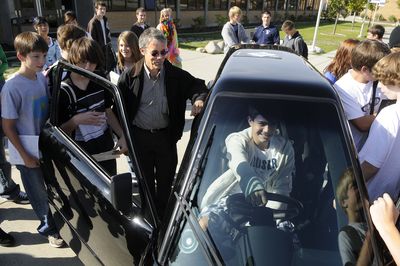Exploring alternative energies
GP debate team charged up after electric car demo

Gonzaga Prep’s debate team may have a slender advantage in competitions this year based on a theme of “alternative energy incentives.”
The Gonzaga debaters got some firsthand information last week from the Spokane Valley designer of an electric car so slim it can slip between lanes of stalled traffic like a motorcycle.
Inventor Rick Woodbury told students in Andre Cossette’s debate class that the United States could save more than a billion barrels of oil a year if 50 million commuters drove one of his 39-inch-wide Tangos.
With enough Tangos in use, traffic congestion and parking shortages could be slashed by splitting some highway lanes and parking stalls.
Woodbury said he got the idea two decades ago while stuck in Los Angeles traffic jams. He discovered that 90 percent of vehicle trips involve only one person.
That’s not likely to change in a culture that prizes personal mobility, Woodbury reasoned. Especially not in cities lacking the population density necessary for mass transit that’s as convenient as driving.
So he designed the Tango with help from his son, Bryan, and has spent a decade trying to bring it to mass production.
The skinny two-seater – one seat in front of the other – can complete a 40-mile commute with 4 kilowatt-hours of electricity. That’s about the amount needed to run a 1,500-watt portable heater for two hours and 40 minutes, Woodbury said.
No extra generating capacity should be necessary, he said.
“Would it kill the electric grid if you added one more heater?”
Anyway, he said people probably would recharge their car batteries overnight when electrical grids have surplus capacity.
But wouldn’t we be trading one dirty fuel for another, a student wanted to know.
Even if all the electricity were generated by burning coal, electric power plants are much more efficient than gasoline engines, Woodbury said. He said electric generation is 80 to 90 percent efficient, compared with 15 percent efficiency for gasoline engines.
What kind of air-conditioning does the Tango have? A really neat one, Woodbury told a student who saw a potential energy pit.
A Tango driver can adjust temperature by controlling the speed of the air-conditioner compressor, allowing just the right amount of cold air to be produced. Typical compressors always crank out the same amount of chill, requiring the air to be reheated if it’s too cold, Woodbury said.
Practical considerations often get in the way of green choices. What about winter driving, a debater asked.
With 25 lead-acid batteries under the floorboards for ballast and with wheels at the very corners of the 75-inch wheel base, the 3,150-pound Tango is extremely stable, Woodbury said.
The model he brought to the school had good traction with rear-wheel drive, but future models probably will have even better traction with front-wheel or all-wheel drive, he said.
It’s pretty hard to roll a Tango, but they come with the kind of roll cages that allow race car drivers to walk away from spectacular 200 mph crashes, Woodbury added.
Speaking of race cars, the Tango is no slouch.
With more than 1,000 foot-pounds of torque and no power-robbing gears, the Tango can go from zero to 60 mph in four seconds and finish a standing quarter-mile drag in 12 seconds at more than 100 mph, Woodbury said.
“It’s really fast, and it’s really fun,” he said. “It just squirts through traffic.”
Jack-rabbit starts are no more efficient in an electric car than in a gasoline model, though. A lead foot can cut the Tango’s 40-mile range in half.
Still, the car is cool enough for actor George Clooney. The car Woodbury brought to G-Prep was used by Clooney and had heavily tinted windows.
“He likes privacy,” Woodbury told one of several dozen students who circled the vehicle for a closer look.
The down side of the Tango is that it costs $108,000 to build by hand, even when it’s not tricked out for a movie star, and even without the $40,000 lithium-ion batteries that could extend its range to 150 miles.
Woodbury believes the cost could be reduced to $20,000 with mass production.
“It would take several billion dollars to set up for production,” he told the G-Prep debaters.
Two auto engineering firms have asked for about $750,000 just to estimate the cost of testing to get the Tango safety certified for mass production, Woodbury said.
With hand production, Woodbury’s Commuter Car Corp. has delivered four Tangos as uncertified “kit” cars. He said the company currently can make only one car every three weeks.
Woodbury hopes to triple his production rate, but knows his only hope of bringing his car to the masses is with the assistance of a major manufacturer.
“It’s just too hard to get people to believe,” he said, acknowledging that such an investment would be “a huge risk.”
That’s where alternative energy incentives might help.
It’s a debate Woodbury hopes the G-Prep students will win.
“That’s what I want to have happen,” he said. “To have the kids say, ‘Hey, this is our generation.’ ”